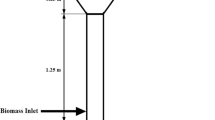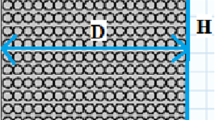Abstract
The thermal characteristics of a natural-gas based cylindrical steam reformer coupled with a combustor are investigated for the use with a 5 kW polymer electrolyte membrane fuel cell. A reactor unit equipped with nickel-based catalysts was designed to activate the steam reforming reaction without the inclusion of high-temperature shift and low-temperature shift processes. Reactor temperature distribution and its overall thermal efficiency depend on various inlet conditions such as the equivalence ratio, the steam to carbon ratio (SCR), and the fuel distribution ratio (FDR) into the reactor and the combustor components. These experiments attempted to analyze the reformer’s thermal and chemical properties through quantitative evaluation of product composition and heat exchange between the combustor and the reactor. FDR is critical factor in determining the overall performance as unbalanced fuel injection into the reactor and the combustor deteriorates overall thermal efficiency. Local temperature distribution also influences greatly on the fuel conversion rate and thermal efficiency. For the experiments, the operation conditions were set as SCR was in range of 2.5–4.0 and FDR was in 0.4–0.7 along with equivalence ratio of 0.9–1.1; optimum results were observed for FDR of 0.63 and SCR of 3.0 in the cylindrical steam reformer.













Similar content being viewed by others
Abbreviations
- PEMFC :
-
Polymer electrolyte membrane fuel cell
- SR :
-
Steam reforming
- HTS :
-
High temperature shift
- LTS :
-
Low temperature shift
- SCR :
-
Steam to carbon ratio
- A/F :
-
Air–fuel ratio
- Fi :
-
Molar flow rate of species i
- LHVi :
-
Low heating value of species i
- ni :
-
Mole of species i
- η :
-
Thermal efficiency
- Ф :
-
Equivalence ratio
References
Wang Y, Chen KS, Mishler J, Cho SC, Adroher XC (2011) A review of polymer electrolyte membrane fuel cells: technology, applications, and needs on fundamental research. Appl Energy 88:981–1007
Larminiie J, Dicks A (2003) Fuel cell systems explained. Wiley, New York
Rostrup-Nielsen T (2005) Manufacture of hydrogen. Catal Today 106:293–296
Authayanun S, Wiyaratn W, Assabumrungrat S, Arpornwichanop A (2013) Theoretical analysis of a glycerol reforming and high-temperature PEMFC integrated system: hydrogen production and system efficiency. Fuel 105:345–352
da Silva AL, Dick LFP, Muller IL (2012) Performance of a PEMFC system integrated with a biogas chemical looping reforming processor: a theoretical analysis and comparison with other fuel processors (steam reforming, partial oxidation and auto-thermal reforming). Int J Hydrog Energy 37:6580–6600
Yuan J, Lv X, Yue D, Sunden B (2009) Transport phenomena coupled by chemical reactions in methane reforming ducts. Int J Transp Phenom 11:39–50
Zhai X, Ding S, Cheng Y, Jin Y, Cheng Y (2010) CFD simulation with detailed chemistry of steam reforming of methane for hydrogen production in an integrated micro-reactor. Int J Hydrog Energy 35:5383–5392
Corbo P, Migliardini F (2007) Hydrogen production by catalytic partial oxidation of methane and propane on Ni and Pt catalysts. Int J Hydrog Energy 32:55–66
Park J, Lee S, Kim S, Bae J (2010) Numerical analysis of the heat and mass transfer characteristics in an autothermal methane reformer. J Fuel Cell Sci Technol 7:051018-1–051018-7
Maximini M, Engelhardt P, Grote M, Brenner M (2012) Further development of a microchannel steam reformer for diesel fuel. Int J Hydrog Energy 37:10125–10134
Lee S, Schwartz WR, Choi J, Ahn J, Kim D, Son I, Kim J, Shin W (2010) Start-up characteristics of commercial propane steam reformer for 200 We portable fuel cell system. Int J Hydrog Energy 35:12286–12294
Morlanes N (2013) Reaction mechanism of naphtha steam reforming on nickel-based catalysts, and FTIR spectroscopy with CO adsorption to elucidate real active sites. Int J Hydrog Energy 38:3588–3596
Cha K, Kim H, Yoo B, Lee Y, Kang K, Park C, Kim Y (2009) Reaction characteristics of two-step methane reforming, over a Cu–Ferrite/Ce–ZrO2 medium. Int J Hydrog Energy 34:1801–1808
Sa S, Silva H, Brandao L, Sousa JM, Mendes A (2010) Catalysts for methanol steam reforming—a review. Appl Catal B 99:43–57
Lin S-T, Chen Y-H, Yu CC, Liu Y-C, Lee C-H (2005) Modelling an experimental methane fuel processor. J Power Sources 148:44–53
Yuan J, Ren F, Sunden B (2006) Analysis of chemical-reaction-coupled mass and heat transport phenomena in a methane reformer duct for PEMFCs. Int J Heat Mass Transf 50:687–701
Heinzel A, Vogel B, Hubner P (2002) Reforming of natural gas–hydrogen generation for small scale stationary fuel cell systems. J Power Sources 105:202–207
Zanfir M, Gavriilidis A (2003) Catalytic combustion assisted methane steam reforming in a catalytic plate reactor. Chem Eng Sci 58:3947–3960
Lee K, Yun J, Ahn K, Lee S, Kang S, Yu S (2013) Operational characteristics of a planar steam reformer thermally coupled with a catalytic burner. Int J Hydrog Energy 38:4767–4775
Davis ME, Davis RJ (2003) Fundamentals of chemical reaction engineering. McGraw-Hill, New York
Suh J, Lee M, Greif R, Grigoropoulos CP (2009) Transport phenomena in a steam-methanol reforming microreactor with internal heating. Int J Hydrog Energy 34:314–322
Roh H, Jun K, Park S (2003) Methane-reforming reactions over Ni/Ce–ZrO2/θ–Al2O3 catalysts. Appl Catal A 251:275–283
Xu J, Froment GF (1989) Methane steam reforming, methanation and water-gas shift: I. intrinsic kinetics. AIChE J 35:88–96
Behnam M, Dixon AG, Wright PM, Nijemeisland M, Stitt EH (2012) Comparison of CFD simulations to experiment under methane steam reforming reacting conditions. Chem Eng J 207–208:690–700
Turns SR (1996) An introduction to combustion: concepts and applications. McGraw-Hill, New York
Lutz AE, Bradshaw RW, Keller JO, Witmer DE (2003) Thermodynamic analysis of hydrogen production by steam reforming. Int J Hydrog Energy 28:159–167
Dubey VR, Vaidya PD (2012) Kinetics of steam reforming of acetol over Pt/C catalyst. Chem Eng J 180:263–269
Acknowledgments
This research was supported by the New and Renewable Energy of the Korea Institute of Energy Technology Evaluation and Planning (KETEP) grant funded by the Korea government Ministry of Knowledge Economy (Grant No. 20133010031751).
Author information
Authors and Affiliations
Corresponding author
Rights and permissions
About this article
Cite this article
Jo, T., Han, J., Koo, B. et al. Thermal analysis of cylindrical natural-gas steam reformer for 5 kW PEMFC. Heat Mass Transfer 52, 2459–2469 (2016). https://doi.org/10.1007/s00231-016-1757-x
Received:
Accepted:
Published:
Issue Date:
DOI: https://doi.org/10.1007/s00231-016-1757-x




